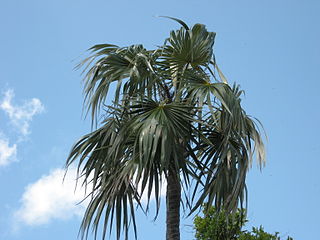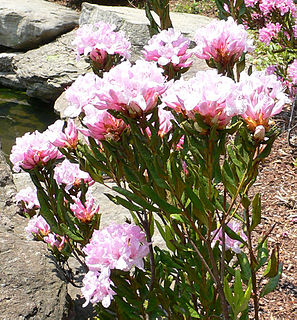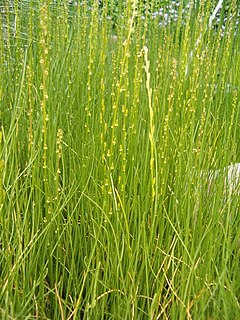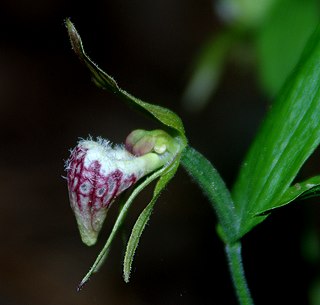
Echium vulgare — known as viper's bugloss and blueweed — is a species of flowering plant in the borage family Boraginaceae. It is native to most of Europe, and western and central Asia and it occurs as an introduced species in north-eastern North America.

Uvularia grandiflora, the large-flowered bellwort or merrybells, is a species of flowering plant in the family Colchicaceae, native to eastern and central North America.

Coccothrinax argentata, commonly called the Florida silver palm, is a species of palm tree. It is native to south Florida, southeast Mexico, Colombia and to the West Indies, where it is found in the Bahamas, the southwest Caribbean and the Turks and Caicos Islands. Its natural habitat is rocky, calcareous soil in coastal scrubland and hammock communities.

Rhododendron minus var. chapmanii, also known as Chapman's rhododendron, is an evergreen shrub which is endemic to Florida. It is an endangered species.
Liatris chapmanii, also known as Chapman's blazing star or Chapman's gayfeather, is a plant species in the aster family Asteraceae and genus Liatris. It is native to Alabama, Florida and Georgia in the United States, where it is found in habitats such as dunes, beach strands, sand ridges, fields and roadsides, it also grows in longleaf pine savannas and other scrub habitats.

Trillium recurvatum, the bloody butcher or prairie trillium, is a spring wildflower in the Melanthiaceae family. It is native to parts of the central and eastern United States, where it is found from Iowa south to Texas and east to North Carolina and Pennsylvania. It natural habitat is mesic forests and savannas, often in calcareous soil.

Triglochin palustris or marsh arrowgrass is a species of flowering plant in the arrowgrass family Juncaginaceae. It is found in damp grassland usually on calcareous soils, fens and meadows. The species epithet palustris is Latin for "of the marsh" and indicates its common habitat. It has a circumboreal distribution, occurring throughout northern parts of the Northern Hemisphere. It can be found locally in the British Isles especially the north.

Quercus chapmanii, commonly referred to as the Chapman oak, is a species of oak that grows in the southeastern United States.

Cypripedium arietinum, the ram's head lady's slipper, is a rare orchid that grows in lightly shaded areas with calcareous soils. It is characteristic of the alvars around the Great Lakes in North America, as well as in New England. In Canada, it is found from Quebec to Saskatchewan, plus an isolated population in Nova Scotia, where it grows on gypsum based soils, 330 km away from the nearest population in Maine.

Thaspium is a genus of flowering plants in the Apiaceae. A common name for the various Thaspium species is meadowparsnip or meadow-parsip.

Trichophorum alpinum is a species of flowering plant in the sedge family known by the common name alpine bulrush. It has a circumboreal distribution, occurring throughout the northern latitudes of the Northern Hemisphere. It is present in Europe, Asia, and northern North America.

Solidago odora, whose English name is sweet goldenrod, also referred to as anisescented goldenrod or fragrant goldenrod is a North American species of goldenrods within the sunflower family. The plant is native to the United States and Mexico, found in every coastal state from Veracruz to New Hampshire and as far inland as Ohio, Missouri, and Oklahoma. It flowers from July through October.

Verbesina virginica, the white crownbeard, is a species of flowering plant in the aster family. It is native to the Southeastern United States, where it is found in calcareous soil, often in bottomland thickets and edges of woods.

Clinopodium ascendens, the common calamint or ascending wild basil, is a perennial plant belonging to the family Lamiaceae.

Hypericum sphaerocarpum, the roundseed St. Johnswort or barrens St. John's wort, is a species of flowering plant in the St. John's wort family. It is native to the Eastern United States where it is primarily found in the Midwest and Mid-South as well as Ontario, Canada. Its preferred habitat is dry, calcareous glades and prairies.

Solidago auriculata, commonly called clasping goldenrod or eared goldenrod, is a species of flowering plant native to the southeastern and south-central United States from South Carolina west as far as eastern Texas and southeastern Oklahoma. It has a patchy distribution and is mostly found in rocky forests over calcareous rocks, although it can be along streams.

Solidago rigida, known by the common names stiff goldenrod and stiff-leaved goldenrod, is a North American plant species in the aster family (Asteraceae). It has a widespread distribution in Canada and the United States, where it is found primarily east of the Rocky Mountains. It is typically found in open, dry areas associated with calcareous or sandy soil. Habitats include prairies, savannas, and glades.
Gaillardia coahuilensis, the bandanna daisy, is a North American species of flowering plant in the sunflower family. It is native to northwestern Mexico (Coahuila) and the southwestern United States.
Acacia chapmanii is a shrub of the genus Acacia and the subgenus Plurinerves. It is native to an area in the Wheatbelt region of Western Australia.

Silphium radula, commonly known as roughstem rosinweed, is a species of flowering plant in the aster family (Asteraceae). It is native North America, where it is found in the South Central region of the United States. Its natural habitat is prairies over sandy or calcareous soil.


















